
My Role: UX/UI Designer
Project Duration: 5 Weeks
Tools Used: Figma, FigJam, Slack, Canvas
About The Project
Empowering families through intuitive task management.
GET START
Project's Overview
In today's fast-paced world, families often struggle to stay organized and connected. Juggling work, school, extracurricular activities, and household chores can lead to stress, miscommunication, and a sense of overwhelm.
FamTask is a UX/UI design concept for a mobile app addressing this challenge, designed to empower families to collaborate seamlessly on task management and scheduling, creating a more harmonious home life.

Problems VS Solutions
Problem
- Parents, especially those with school-aged children, struggle to juggle work, household chores, and kids' activities. Lack of coordination leads to stress, missed tasks, and frustration. Existing tools (like Google Keep or calendar apps) aren't designed to meet the needs of busy families.
Solution
- FamTask simplifies task delegation, gives parents a clear overview of family responsibilities, and motivates children to complete chores through a reward system. The app centralizes family tasks in one place, enhancing communication and reducing stress.
Our Roadmap
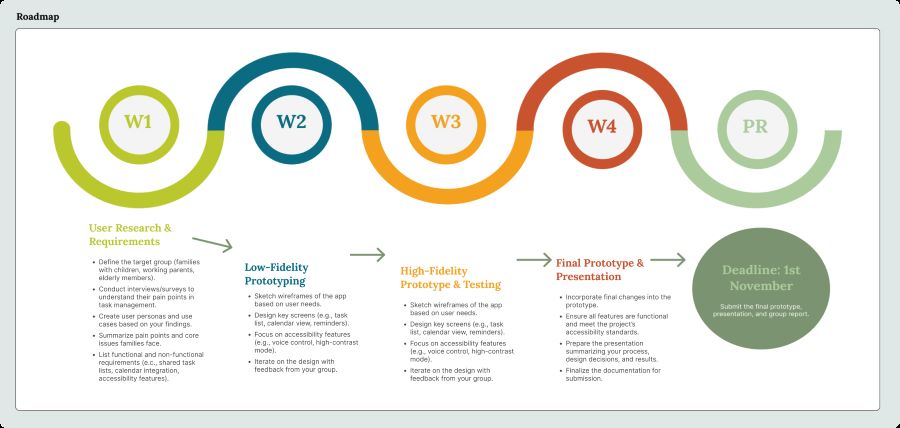
Understanding the Users
Our team recognized the need to deeply understand the challenges and motivations of our target users. We conducted semi-structured interviews with seven parents to gain insights into their daily routines, pain points, and desired outcomes.
Parents wanted an app that proactively reminded both themselves and their children about upcoming tasks, reducing the need for constant nagging.
Users craved a simple, at-a-glance view of all tasks, assignments, and deadlines.
Parents struggled to engage children in household chores without constant reminders or conflict.
Parents expressed the need for a system that allows children to check off completed tasks, fostering a sense of responsibility and accountability.
The Challenge
Busy families often face several key challenges.
Disorganization
Lack of a central system to track tasks and responsibilities.
Miscommunication
Difficulty coordinating schedules and ensuring everyone is on the same page.
Unequal Burden
Imbalance in household chores, leading to resentment and conflict.
Motivational Issues
Difficulty engaging children in household tasks and responsibilities.
Persona
Based on these insights, we created a user persona to represent our target audience.
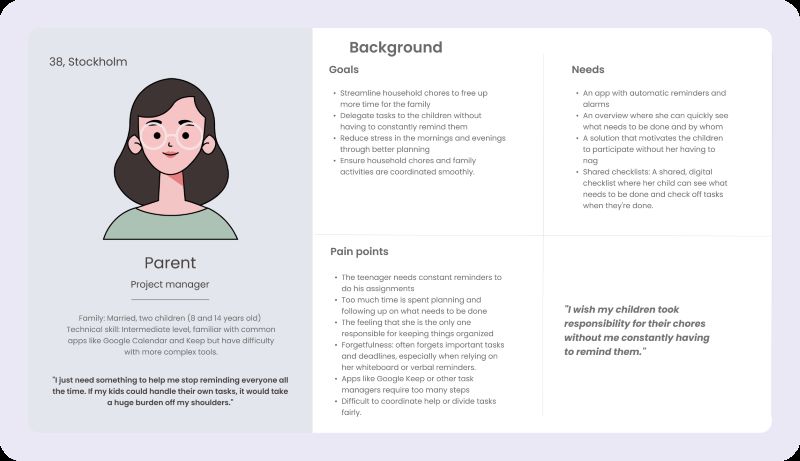
Journey mapping
To gain further empathy, we mapped out a typical day for Nathalia, identifying key pain points and opportunities for our app to provide value. This involved mapping out the high and low points of the day and identifying areas for the app to assist in.
Design process
Our design process followed a user-centered approach, iterating based on user feedback and usability testing.

Initial Design Concepts
Our initial design focused on a clean and intuitive interface with several core features. This approach ensures user engagement and facilitates easy navigation throughout the app. Additional design considerations focused on accessibility and inclusivity.
Task Creation and Assignment
Parents have the ability to assign tasks with set deadlines to children and family members.
Progress Tracking
Visual representation of task completion.
Shared Calendars
Centralized schedule view for the whole family.
Rewards System
Motivate children through gamification and incentives.
Different account user
For children, focus on what tasks they should focus on. For parent, overview of the task they are assign.
Accessibility considerations
Ensuring accessibility was a core priority throughout the design process. Here's how we addressed key accessibility guidelines:
Utilized headings (H1, H2, H3), body text, and text boxes to create a logical content structure for screen readers.
Selected easily readable fonts and ensured sufficient text size (minimum 16px for body text, 24px for headings) for readability.
Provided descriptive alt text for all images and icons, ensuring screen readers can convey their purpose (implementation planned for the development phase).
Used clear, concise, and descriptive button labels, avoiding vague terms like 'Click Here.'
Ensured buttons are at least 44x44 pixels with adequate spacing to prevent accidental presses.
We plan to implement ARIA attributes during development to further enhance screen reader support and ensure WCAG compliance. We also plan to be extremely aware of any color contrast issues.
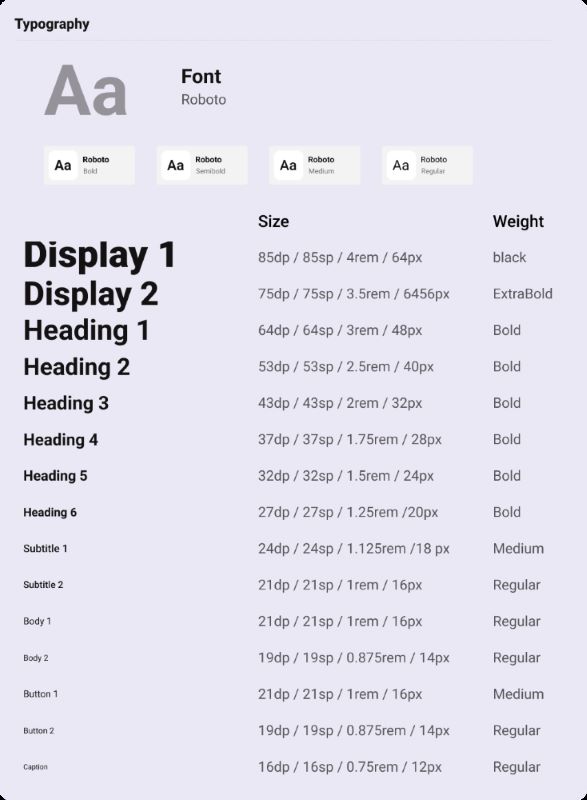

Key Features
Separate login accounts for parents (admins) and children (members).
Admin have the access to be able to add family up-keeping tasks on a list.
Allow parents and children to view a family calendar, children are only to see task assign to themselves.
Parents have the ability to track their children's progress in the app.
Avatar, Simple, intuitive interface with visual cues (custom avatar).
Users are able to access a notification section to see their upcoming tasks.
Responding to user feedback iteration 1
Following the initial usability tests, we identified several key areas for improvement and iterated on our design accordingly.
Responding to user feedback iteration
- 👉 Overcrowded Homescreen: The initial design of the homescreen for the app was cluttered and overwhelming.
- 👉 Calendar Usability: Users expressed they wanted the calendar to only showcase their task, not the family.
- 👉 Navigation Issues: Users had difficulty navigating back to the main homescreen from certain sections of the app.
Changes implemented iteration
- 👉 Simplified homescreen: Removed redundant 'To-Do' and 'Calendar' tabs, consolidating navigation into a bottom bar. Refined color scheme and button layout.
- 👉 Personalized Calendar View: Filtered calendar view to display only tasks assigned to the specific user.
- 👉 Improved Navigation: Moved the 'Back' button to a more conventional location in the bottom navigation bar.
Ethical design considerations and further refinement
During our second iteration, we conducted an ethical design workshop to identify and address potential negative impacts of our app.
Responding to user feedback iteration
- 👉 Ethical consideration: The ethical implications of constantly being reminded of tasks may induce mental anxiety for children.
- 👉 Ethical consideration: A high volume of bright colors and gamified animated designs may induced cognitive overload for children.
Changes implemented iteration
- 👉 Removal of aautomatic reminders: Removed automatic reminders and implemented a notification section where users can check their upcoming tasks on their own terms.
- 👉 Simplified children's interface: After the first round of user testing of both admins and member accounts, we switched the interface to be more minimal and neutral.
- 👉 Avatar integration: We decided to integrate custom avatars into the application's UI to provide the user with a friendly face and sense of personalization while minimizing cognitive load.
Visual Design
Task Creation
Empower parents to easily design and assign tasks with clear details—name, description, deadline, and rewards. Tasks can be tailored to an individual child or shared with everyone.
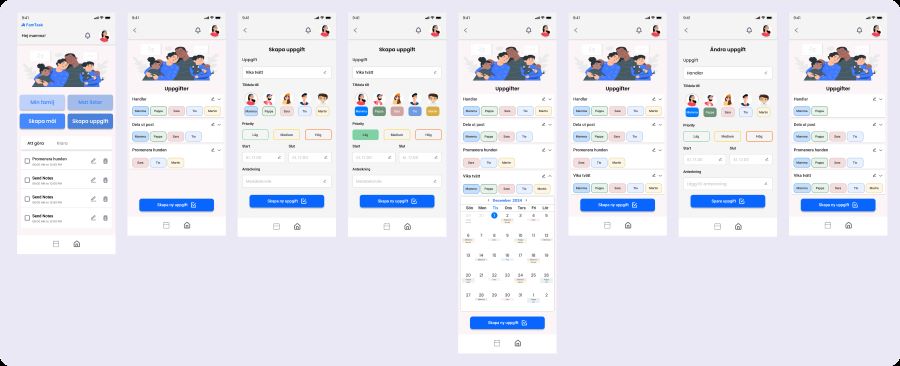
Goal Setting
Foster collaboration with a simple, intuitive interface where parents and children set shared goals. Visual progress trackers keep everyone motivated and celebrate achievements.
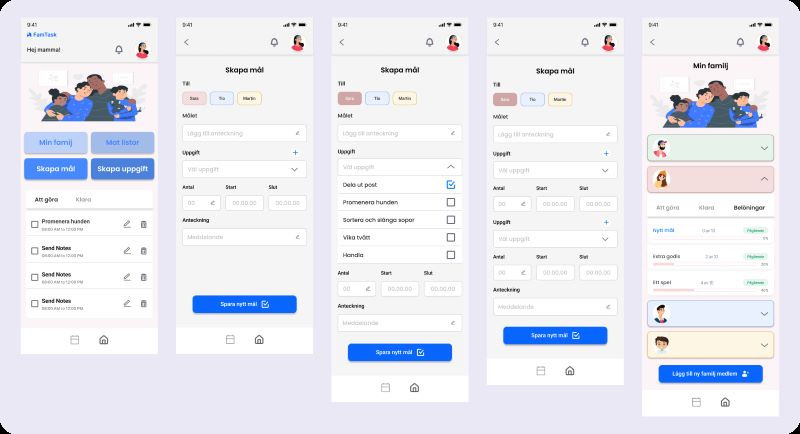
Personalized Calendars
Separate calendars display tasks and activities for both children and parents. Parents get a comprehensive overview with full control to view, add, or edit events, while children enjoy a streamlined view with the ability to manage their own activities. Alerts and deadlines ensure nothing is missed.
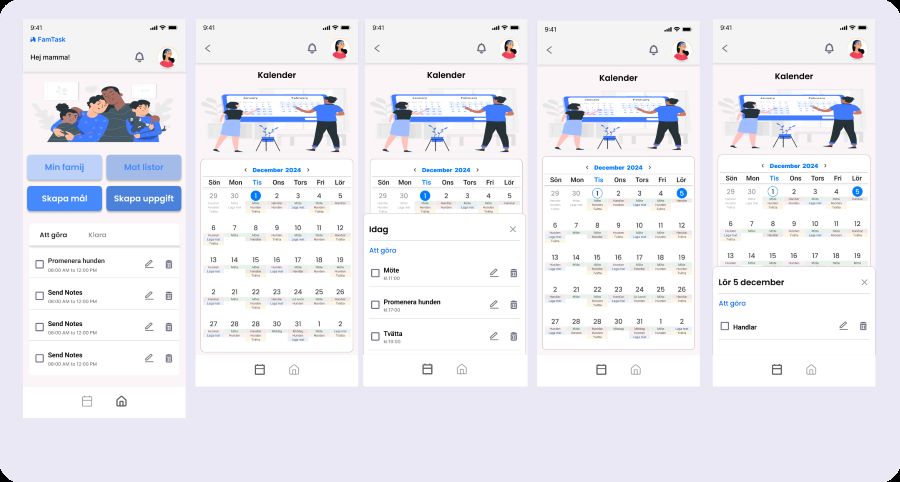

Child-Friendly Profiles
Young children benefit from engaging, simplified profiles featuring vivid images, animations, and visual rewards—making navigation intuitive and fun.

Customized Child Profiles
Each child's profile showcases their personalized tasks, rewards, and a dedicated calendar—empowering them to take charge of their own progress.

Comprehensive Parent Profiles
Parents enjoy a robust dashboard displaying their role, family overview, and real-time insights into their children's tasks and goals. With easy management tools and instant notifications, staying on top of family activities is effortless.

Measuring success
The success of FamTask will be measured by the following KPIs:
✨ Reduced parental stress levels least 1 point
Decrease in self-reported stress levels among parents after regular app usage (measured on a scale of 1-5).
✨ Time savings for parents reduce follow-up time by at least 20%.
Reduction in the time parents spend manually tracking chores and reminding children.
✨ Increased task completion by 70%
Increase in the percentage of tasks completed independently by children, without parental reminders.
✨ Improved family communication by 70%
Increase the harmony of the household and how well tasks are handled. Both parent and children feel that tasks are being handled equally.
Lessons learned
The power of user feedback
Usability testing and user interviews are essential for identifying design flaws and refining the user experience. Even features we initially thought would be effective (e.g., automatic reminders) needed to be reconsidered based on user feedback.
Ethical design considerations
It's crucial to consider the potential negative impacts of our designs and make adjustments to mitigate harm. In our case, we removed automatic reminders to prevent anxiety and simplified the children's interface to reduce cognitive load.
Simplicity is key
A clean, intuitive interface is essential for engaging users of all ages. Even for child-centric designs, simplicity and clarity should be prioritized.
Next steps
Broader range of families
We will conduct additional usability testing with a broader range of families.
Accessibility features
We will develop a detailed plan for implementing ARIA labels and other accessibility features during the development phase.
Finalize design prototype and get feedback
We will build a high-fidelity prototype and conduct further user testing and explore integrations with other popular calendar and task management apps.
We will iterate and improve the application from our targets feedback!
Future Development
We will conduct a beta test to gather real-world feedback and refine the app before launch.
The app will be optimized for performance across all devices, ensuring a smooth user experience, even on older phones.
We will add two-way syncing with calendars like Google Calendar to allow families to manage both tasks and events in one place.
Post-launch, we will continue collecting feedback to improve FamTask, including adding features like a chores marketplace for kids to pick extra tasks for rewards.
Conclusions
FamTask is a UX/UI design concept with the potential to significantly improve the lives of busy families.
By focusing on user needs, iterating based on feedback, and prioritizing accessibility, we can create a powerful tool that empowers families to collaborate, stay organized, and reduce stress.
